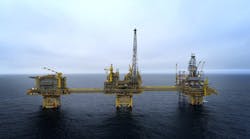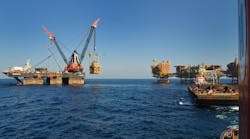Environmental targets met using inverted emulsion mud
Benjamin Paiuk, Oscar Daparo - M-I SwacoDaniel Aquino - ChevronTexaco Argentina
The environmental and economic impacts of using an inverted-emulsion drilling fluid were mitigated by managing mud constituents and treatment to reduce retention on cuttings. An Integrated Fluids Engineering (IFE) concept was employed to realize these and additional benefits. The IFE concept incorporated a team consisting of project engineer, IFE coordinator, mud engineer, solids control equipment technician, and technical support.
The operator’s main interest was to reduce liquid effluents to minimize the environmental impact of using an invert-emulsion drilling mud by reducing the volume of waste generated in each drilling stage. Lithology of the well required that drilling fluid be used to help manage formations with reactive clays, salt mantle-rocks and depleted sands. Otherwise, problems with lost circulation and wellbore instability were encountered in the area.
To achieve the goal, the drilling plan called for reducing both mud cutting retention (MCR) and cutting oil retention (COR), and for determining the optimal surfactant concentration to minimize the volume of mud lost on cuttings wetting.
Reduction of MCR and COR resulted in less volume of new mud required as compared to previous area wells. This also helped reduce the total volume of drilling fluid used.
Invert-emulsion storage tanks were used to store and reuse the mud in subsequent wells. That minimized preparation of fresh volumes of mud at the rig, which translated into saving in gas/oil consumption for mud preparation purposes.
Because the mud was being reused, improvements in solids control equipment efficiency and in reduction of the waste volume due to MCR and COR were made to avoid buildup of low particle size distribution solids in the mud.
The mud formula used in the second stage of drilling contained the special surfactant in order to minimize MCR and COR. That reformulation solved the problem of cutting becoming stuck in the primary shale shakers screens and also in the mud cleaner. This problem had the effect of reducing the hardware working life. With the reformulation, an increase in shaker screen duration allowed the use of screens with greater mesh sizes, resulting in increased efficiency and reduced screen consumption.
By using the formula which modified the degree and type of drill solids wetting and optimized control of the solids, the objective of reducing the amount of mud retained on the cuttings exceeded the target established at the beginning of the project. This also translated into a reduction in the amount of fresh mud volume required. The modified system removed 62.9% of the solids from the primary shakers, an improvement from the 53% seen prior to the changes. The COR on solids discharge was reduced from 24% to 16%.
One major problem affecting drilling solids control was eliminated with the revised mud formula. Before, cuttings were sticking to the surface of the shale shaker screens, necessitating the use of low mesh screens - 40-60 in the primary shakers and 175 in the mud cleaner - to prevent excessive mud loss. After the reformulation, 140-175 mesh was run in the primary shakers and 205-325 in the mud cleaner. That produced an increased efficiency downstream in the decanter. In addition, the useful life of the screens was increased because the abrasive cleaning materials used before were not necessary. Before the change, shaker screens were lasting 80-100 hours or less. After the changeover, average screen duration at the primary shakers went to 320 hours and the useful life of the mud cleaner screens ranged from 350-550 operating hours.
Although there was an increased cost in additive consumption with the new formula, the total mud cost was reduced because less make-up oil was needed.
Chevron began as operator at El Trapial field in 1991 and has drilled around 700 wells to date. The typical drilling program calls for drilling to 120 m with a bentonitic water-base mud using a 12 1/4-in. bit and 9 5/8-in. casing. The second stage uses the invert emulsion mud with 8 1/2-8 3/4-in. bits and 7-in. casing. Drill time in this second stage runs 50-70 hours.






